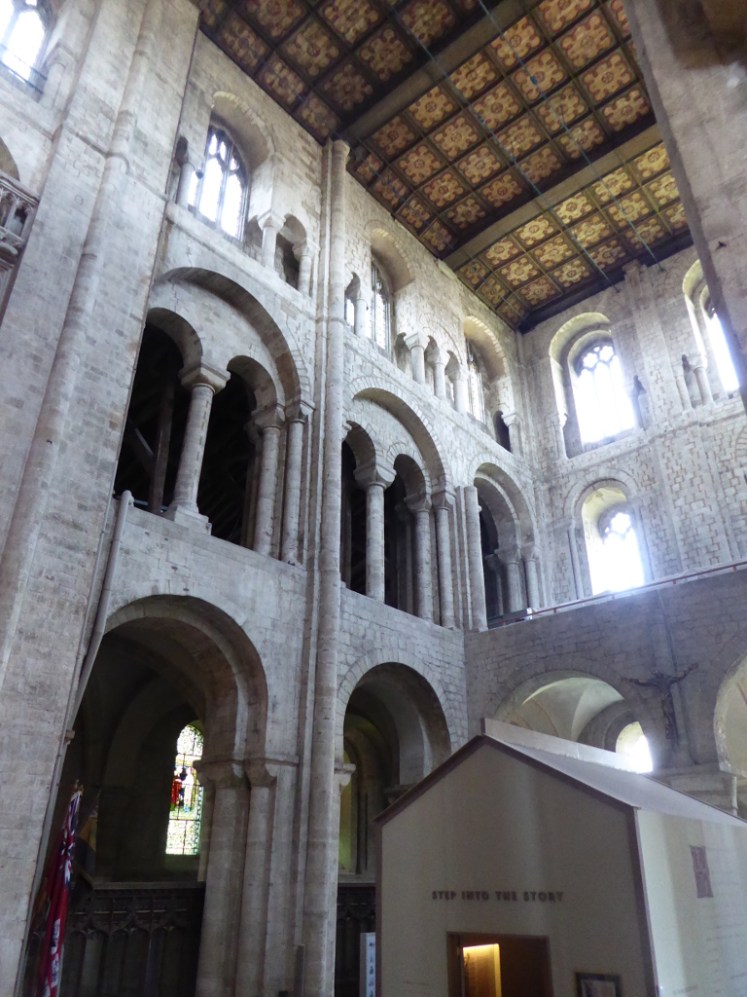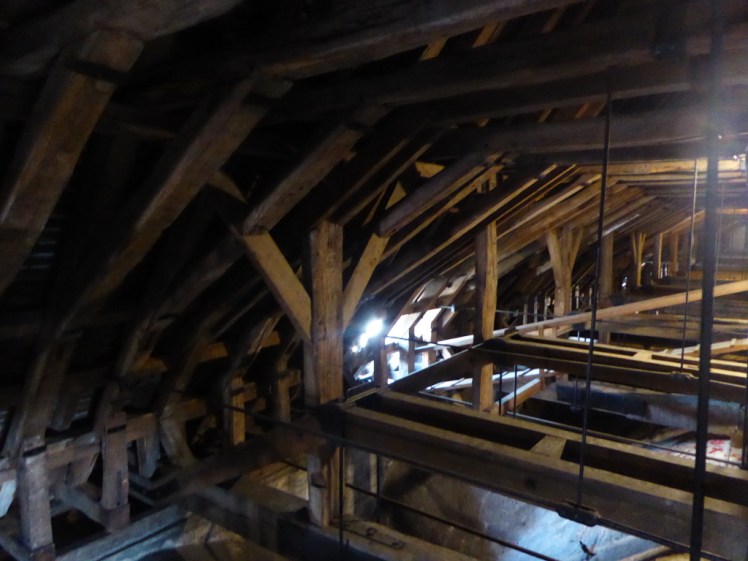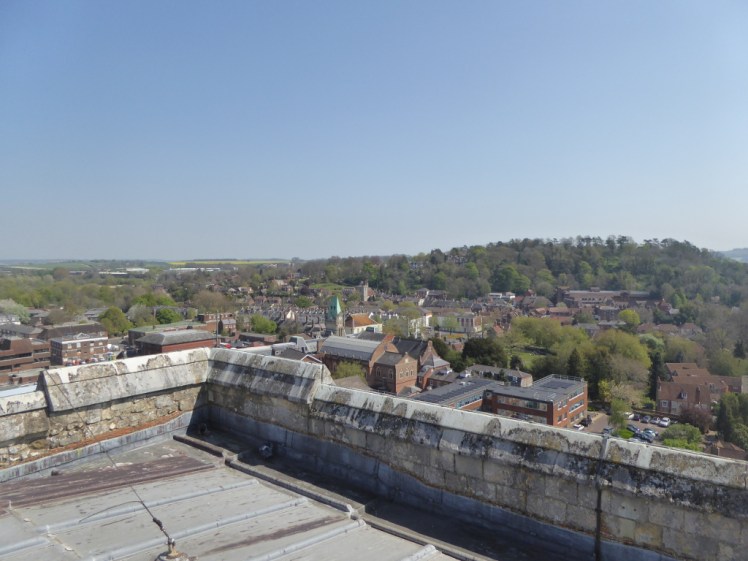Last Monday, a lot of big old heavy solid permanent monuments very suddenly became a lot less permanent. My reaction to the Notre Dame fire, once it had been established that most of the building had miraculously survived, was to book flights to Rome next month, primarily to see the Sistine Chapel. I also went to Winchester Cathedral.
I go to Winchester quite regularly. They have a Primark there and one of my favourite theatres and a friend used to live there. In recent years, I’ve taken an interest in the cathedral because it’s the last resting place of King Cnut, called the Great. He was a Viking king, king of Denmark and Norway – oh, and England. From what I’ve read, despite coming under the “invader” side of the “Invaders & Settlers” period, as per Year Four history lessons, Cnut sounds like he actually was a pretty good king.
But I’ve never been and visited him at Winchester Cathedral because there’s an entrance fee. Given the events of less than five days ago (as I write this), I thought I could manage £8.50 to see something that could burn to the ground any second.

I started with the ground tour. That’s just your average guided tour of the cathedral interior. It’s included in the ticket price if you want to do it and it takes about a hour.

I learned a lot. Winchester Cathedral itself dates back to 1079 and was consecrated in 1093, a legacy of William the Conqueror, who started a programme of building French-style cathedrals across England – others include Durham, York, Canterbury, Lincoln and the pre-1666 pre-Great Fire St Paul’s in London. That means the church I came looking for doesn’t actually exist anymore – the church Cnut was buried in would have been the Old Minster which was on the same site and demolished when the new Norman cathedral was completed. There are half a dozen Saxon royals and VIPs buried on the site – well, buried next door. Their bones are now mixed up in six mortuary chests.

Winchester Cathedral was originally built in the Norman style, three storeys, round arches, bad masonry. The builders had never built anything like this and didn’t really know what they were doing. The central tower collapsed, probably because of shoddy building work but possibly in rage at the burial of William Rufus underneath it. He’s now mixed up in the mortuary chests too and the tower was rebuilt.

In the mid-14th century, they began extensive remodelling to turn the cathedral from Norman style to Perpendicular Gothic, two storeys and pointed arches, soaring up to God. The original west towers, a little like Notre Dame’s, were lost in the restoration – they were in bad condition and it was cheaper to demolish them than to rebuild them. So the cathedral became forty feet shorter at its west end. It took around a century to reconstruct the church, stripping and rebuilding one section at a time to make sure nothing collapsed. The new Gothic arches were much stronger, able to support elaborate new vaulting. But the money ran out and the north & south transepts are both the original architecture – dodgy, if you remember, and yet still standing 926 years later.

The last interesting architectural point is that the southern end nearly sank into the peat underneath. The diver William Walker spent six hours a day six days a week for six years dropping concrete down in the mud underneath and most likely single-handedly saved half the cathedral from collapsing. There are now steel bars holding the south side to the north side and flying buttresses to prop it up from the outside. You can literally see the lopsided angle inside the cathedral – compare the straight lines of the chantry chapel on the left to the cathedral wall on the right in the picture above.

So let’s go up the tower. It’s the Norman original – well, the replacement for the collapsed one and it dates from around 1100. It’s no spire, this is no Salisbury, highest spire in the country at 123m, worth coming all the way from Moscow to see – Winchester Cathedral has a squat little square tower 46m high, just 11m higher than the ridge of the transepts that run each side of it. To get up there, we took the spiral stairs from the western end and crossed the beams above the nave.

It’s all wood up in the roof, ancient oak beams. Yeah, have we heard that before somewhere lately? The beams are reinforced by Victorian engineering to make sure their weight doesn’t push the priceless vaulting below down into the vaults and following the York Minster fire, drainage holes were added in the 1980s to make sure the weight of water in the event of a fire wouldn’t destroy everything up there. My guide added that they’re probably going to have another think about fire safety very soon.

At the other end of this roof is the bellringing room, quite elaborate in architecture (nearer to God, you see) and in decoration, although by decoration I mean striped sallies hanging from the ceiling, notice boards and boards commemorating notable peals – 5040 changes makes a peal and it takes about four hours. Plus the highest toilet in Winchester. Bad news is it’s out of order and gents only.

From here, we went up to see the bells themselves. It’s a really narrow really steep stone spiral staircase. If you’ve read my blog on St Olaf’s in Tallinn, you’ll know I’m not a fan of stone spiral stairs. I treated it like a ladder, climbing as much with hands as with feet. And then we were in the bell chamber. There are sixteen of them, the biggest being the 1.8 ton tenor. They’re rung full circle, which means they’re attached to a big wheel mechanism and swung round 360°. The bell hits the stop at the top but the clapper keeps going which is why it dongs and then the same in the other direction. Apparently it’s the most accurate way of ringing church bells. There are shutters up here, most kept closed because the clergy of the day lived near the south side of the cathedral and found it too noisy. They open the shutters for weddings nowadays because, well, people have paid to be able to hear the bells. They half-muffle them, or even full-muffle them on occasions – St Swithun’s Day, New Year’s Eve and on the death of the monarch (“We haven’t had one of those in a while, knock on wood”, as if she wasn’t 93 yesterday), by strapping a leather pad or two to the clapper.

And now more stairs to the roof. They’re so small and so narrow and so dark and every time I meet a window the light whites out my vision so I can’t see the next few steps.

I was kind of expecting to be terrified of standing on top of the tower because I’m increasingly not a fan of heights but it’s fine. For one thing, as I said, it’s pretty short and stumpy and also you stand right in the middle of the tower, a good few feet from the edge, hemmed in by yellow railings. You’re not falling off that thing. Great views from up there. You can see all of Winchester. It’s not growing to the east or west because there are hills in the way and it’s not growing to the north or south because that’s a river and also any buildable land belongs to people who either aren’t going to sell it or are going to demand far too much money.
Going back down the tower was terrible. It’s so narrow and dark and the steps are so small. You walk down penguin-style, feet pointed right out, left foot sideways on the step, right foot nearly sideways on the step below. You’re supposed to wrap your arm around the central column but that’s not really practical so I pressed my elbows onto each side and panicked when the wall vanished with each window. We went past the bell chamber, which was where the steps were really badly born, and eventually emerged back into the east end of the roof above the nave.

We paused back at the west end. The window here is full of dead flies – like really full – and there’s a wooden chair once inhabited by a wartime firewatcher. Winchester wasn’t bombed. Nearby industrial Southampton took most of the brunt of that but apparently “we have it on good authority” that Hitler planned to be crowned at Winchester Cathedral, like William the Conqueror, and also to seat his government at Oxford, which also escaped bombing. And it was at this point that we were informed that the west wall is literally a wall. It’s Europe’s biggest free-standing wall. It’s not really attached to the rest of the cathedral. That’s terrifying. It’s been standing since the fourteenth century.

Last of all, we went out over the south roof, minding the drainage gullies, which are holes nearly a foot long and getting on for a foot deep. This is a lot lower, overlooking the quieter less obviously public gardens – plus a rental building belonging to the cathedral that rents for somewhere in the region of £5,000 a month. Apparently it’s vacant a lot of the time.
The spiral stairs back down to the ground seemed so easy after the tower stairs. Ok, going round and round in circles for 35m non-stop will eventually make you a bit dizzy but it was a luxury compared to the bell tower steps.
So that was an item crossed off my one-day list. Soon I’ll do Salisbury Cathedral too, which I expect to be a very different experience.